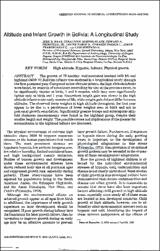Mostrar el registro sencillo del ítem
Altitude and infant growth in Bolivia : a longitudinal study
| dc.contributor.author | Haas, Jere D | |
| dc.contributor.author | Moreno-Black, Geraldine | |
| dc.contributor.author | Frongillo, Edward A | |
| dc.contributor.author | Pabon A, Javier | |
| dc.contributor.author | Pareja L, Gerardo | |
| dc.contributor.author | Ybarnegaray U, Jorge | |
| dc.contributor.author | Hurtado G, Luis | |
| dc.date.accessioned | 2022-02-22T18:11:07Z | |
| dc.date.available | 2022-02-22T18:11:07Z | |
| dc.date.issued | 1982 | |
| dc.identifier.uri | http://repositorio.umsa.bo/xmlui/handle/123456789/27195 | |
| dc.description.abstract | ABSTRACT The growth of 79 healthy, well-nourished lowland (400 M) and highland (3600 M) Bolivian infants was analyzed in a longitudinal study through the first postnatal year. Compared to low altitude infants, the high altitude infants were found, by analysis of covariance controlling for size at the previous exam, to be significantly shorter at birth, 1 and 6 months, while they were significantly lighter only at birth and 1 year. Recumbent length gain was slower in the high altitude infants in the early months of life, while weight gain did not differ between altitudes. The observed lower weights at high altitude throughout the first year appear to be due to a persistence of lower weights seen at birth and not to postnatal growth retardation. Significantly greater triceps and subscapular skinfold thickness measurements were found in the highland group, despite their smaller length and weight. The possible causes and implications of the greater fat accumulation in the Highland infants are discussed. | es_ES |
| dc.language.iso | en | es_ES |
| dc.publisher | American Journal of Physical Anthropology | es_ES |
| dc.subject | ALTA ALTITUD | es_ES |
| dc.subject | HIPOXIA | es_ES |
| dc.subject | INFANCIA | es_ES |
| dc.subject | CRECIMIENTO FÍSICO | es_ES |
| dc.title | Altitude and infant growth in Bolivia : a longitudinal study | es_ES |
| dc.type | Article | es_ES |

